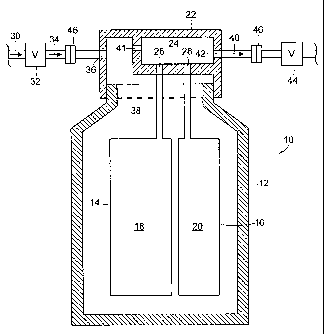Some of the information on this Web page has been provided by external sources. The Government of Canada is not responsible for the accuracy, reliability or currency of the information supplied by external sources. Users wishing to rely upon this information should consult directly with the source of the information. Content provided by external sources is not subject to official languages, privacy and accessibility requirements.
Any discrepancies in the text and image of the Claims and Abstract are due to differing posting times. Text of the Claims and Abstract are posted:
| (12) Patent Application: | (11) CA 2584473 |
|---|---|
| (54) English Title: | LIQUID MIXTURE DISPENSING SYSTEM |
| (54) French Title: | SYSTEME DE DISTRIBUTION DE MELANGE LIQUIDE |
| Status: | Deemed Abandoned and Beyond the Period of Reinstatement - Pending Response to Notice of Disregarded Communication |
| (51) International Patent Classification (IPC): |
|
|---|---|
| (72) Inventors : |
|
| (73) Owners : |
|
| (71) Applicants : |
|
| (74) Agent: | SMART & BIGGAR LP |
| (74) Associate agent: | |
| (45) Issued: | |
| (86) PCT Filing Date: | 2005-10-11 |
| (87) Open to Public Inspection: | 2006-05-04 |
| Examination requested: | 2007-09-21 |
| Availability of licence: | N/A |
| Dedicated to the Public: | N/A |
| (25) Language of filing: | English |
| Patent Cooperation Treaty (PCT): | Yes |
|---|---|
| (86) PCT Filing Number: | PCT/US2005/036481 |
| (87) International Publication Number: | WO 2006047083 |
| (85) National Entry: | 2007-04-18 |
| (30) Application Priority Data: | |||||||||
|---|---|---|---|---|---|---|---|---|---|
|
A liquid dispensing system comprises a container (112) containing at least one
flexible bag (14, 16). A first liquid (18, 20) is contained in the bag. A
manifold chamber (24) is in communication with the bag via a first metering
orifice (26, 28), and with the interior of the container (12) via a second
metering orifice (41). A second liquid (38) is introduced under pressure into
the container. The thus introduced second liquid serves to pressurize the
first liquid in the bag, with the first and second metering orifices serving
to respectively admit metered amounts of the first and second liquids into the
manifold chamber for combination into a liquid mixture dispensed through an
outlet (42).
Cette invention concerne un système de distribution de liquide comprenant un récipient (112) contenant au moins un sac souple (14, 16). Le sac contient un premier liquide (18, 20). Une chambre de collecte (24) communique avec le sac par l'intermédiaire d'un premier orifice de dosage (26, 28) et avec l'intérieur du récipient (12) par l'intermédiaire d'un second orifice de dosage (41). Un second liquide (38) est introduit sous pression dans le récipient. Le second liquide ainsi introduit sert à mettre le premier liquide sous pression dans le sac, le premier et le second orifice de dosage servant respectivement à laisser entrer des quantités dosées du premier et du second liquide dans la chambre de collecte afin qu'ils soient combinés en un mélange liquide distribué par un orifice d'évacuation (42).
Note: Claims are shown in the official language in which they were submitted.
Note: Descriptions are shown in the official language in which they were submitted.

2024-08-01:As part of the Next Generation Patents (NGP) transition, the Canadian Patents Database (CPD) now contains a more detailed Event History, which replicates the Event Log of our new back-office solution.
Please note that "Inactive:" events refers to events no longer in use in our new back-office solution.
For a clearer understanding of the status of the application/patent presented on this page, the site Disclaimer , as well as the definitions for Patent , Event History , Maintenance Fee and Payment History should be consulted.
| Description | Date |
|---|---|
| Time Limit for Reversal Expired | 2010-10-12 |
| Application Not Reinstated by Deadline | 2010-10-12 |
| Deemed Abandoned - Failure to Respond to Maintenance Fee Notice | 2009-10-13 |
| Letter Sent | 2007-10-22 |
| Request for Examination Received | 2007-09-21 |
| Request for Examination Requirements Determined Compliant | 2007-09-21 |
| All Requirements for Examination Determined Compliant | 2007-09-21 |
| Letter Sent | 2007-09-11 |
| Inactive: Single transfer | 2007-07-13 |
| Inactive: Cover page published | 2007-07-03 |
| Inactive: Incomplete PCT application letter | 2007-06-29 |
| Inactive: Notice - National entry - No RFE | 2007-06-29 |
| Inactive: First IPC assigned | 2007-05-10 |
| Application Received - PCT | 2007-05-09 |
| National Entry Requirements Determined Compliant | 2007-04-18 |
| Application Published (Open to Public Inspection) | 2006-05-04 |
| Abandonment Date | Reason | Reinstatement Date |
|---|---|---|
| 2009-10-13 |
The last payment was received on 2008-09-30
Note : If the full payment has not been received on or before the date indicated, a further fee may be required which may be one of the following
Please refer to the CIPO Patent Fees web page to see all current fee amounts.
| Fee Type | Anniversary Year | Due Date | Paid Date |
|---|---|---|---|
| Basic national fee - standard | 2007-04-18 | ||
| Registration of a document | 2007-07-13 | ||
| Request for examination - standard | 2007-09-21 | ||
| MF (application, 2nd anniv.) - standard | 02 | 2007-10-11 | 2007-09-27 |
| MF (application, 3rd anniv.) - standard | 03 | 2008-10-14 | 2008-09-30 |
Note: Records showing the ownership history in alphabetical order.
| Current Owners on Record |
|---|
| GLOBAL AGRICULTURAL TECHNOLOGY AND ENGINEERING, LLC |
| Past Owners on Record |
|---|
| JOHN R. NEWTON |